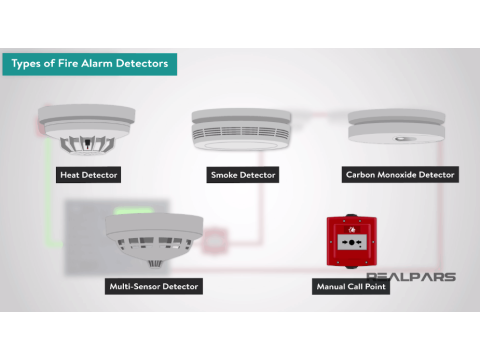Security and fire alarm systems (collectively called “OPS” in some regions) depend on detectors (or “sensors”) to identify threats—be it intrusion, fire, or other emergencies. These sensors come in numerous types, each designed to detect specific risk factors (e.g., motion, temperature increase, smoke, or flame) and to relay that information to a control panel. Below, we break down the main categories of security and fire sensors, their operating principles, and their classification based on coverage type and signal methods.
Detectors by Application
Security Sensors (Intrusion)
- Detect unauthorized entry attempts: door/window openings, glass breakage, motion, vibration, etc.
- Used in burglar and perimeter alarm systems.
Fire Sensors
- Identify early signs of fire: smoke, rapid temperature changes, or flames.
- Usually integrated into stand-alone fire alarm systems or combined with security (as combined OPS).
How Sensors Work
Regardless of application (security or fire):
Sensitive Element (Sensor/Transducer)
- Reacts to a change in the environment—smoke, temperature, pressure, light, movement, etc.
- Produces an electrical impulse proportional to that change.
Signal Processing Circuit
- Interprets the raw impulse from the sensor.
- Decides whether to trigger an alarm relay, send a coded alert, or initiate other responses.
Modern sensors range from simple “closed or open relay” outputs to sophisticated addressable or wireless devices that transmit detailed digital information.
Detector Classifications
1. By Zone (Detection Coverage)
Point (Spot) Detectors
- Monitor conditions at the exact point of installation.
- Common in fire alarms (e.g., spot smoke or heat detectors) and in security (e.g., magnetic contacts for doors/windows).
Linear Detectors
- Protect extended lines or routes (e.g., perimeter fences, overhead cable trays).
- Can be used for both security (like beam sensors) and fire (like thermal cables or beam smoke detectors).
Surface Detectors
- Typically found in security systems.
- Create a “curtain” or “plane” of coverage to protect windows, doors, or walls.
Volumetric (Area) Detectors
- 3D coverage of a room or space.
- Includes motion detectors (security) and flame sensors (fire).
2. By Signal Transmission
Wired
- Communicate via electrical cables (also called “loops” or “zones”).
- Generally more robust (constant supervision of wiring), often cheaper than wireless sensors.
- Broad device compatibility—many brand options.
Wireless (Radio-Channel)
- No cable runs needed—easier retrofits in finished buildings.
- Battery-powered, needing periodic replacements.
- Susceptible to signal interference; range can be limited by walls or metal structures.
3. By Sensor Output (Informative Level)
Threshold (Non-Addressable)
- Often just two states: “normal” or “alarm.”
- Typically represented by a relay that’s either “open” or “closed.”
- Doesn’t distinguish between a genuine alert and a possible sensor fault (open circuit could mean a triggered alarm or a wiring break).
Addressable
- Each sensor has a unique digital address, so the control panel knows exactly which device triggered.
- Allows additional data—fault, tamper, maintenance alerts, etc.
- Increases system reliability and diagnostic capabilities.
Examples: Security & Fire Detectors
Security Sensors
Magnetic Contacts:
- Point detectors for doors, windows, or hatches.
- Common in intrusion alarms—rely on a magnet and reed switch design.
Glass-Break & Vibration Sensors:
- Monitor shock waves or acoustic frequencies associated with glass shattering.
- Linear or surface coverage.
Motion Detectors (Volumetric):
- Often infrared (PIR) or microwave.
- Cover an area/volume for movement detection.
Perimeter Beams (Linear):
- IR or microwave beams for fence lines or large building exteriors.
Fire Sensors
- Smoke Detectors:
- Point or beam types—photoelectric (optical) or ionization.
- Heat Detectors:
- Maximum (fixed-temp), rate-of-rise, or combination.
- Used in kitchens, garages, dusty areas where smoke detectors might misread conditions.
- Flame Detectors:
- Volumetric sensors detecting IR/UV light from visible flames.
- Common in industrial or high-hazard sites.
Selecting the Right Detector
Consider the following factors:
- Environment: Dust, humidity, open-air coverage for large warehouses, or specialized industrial hazards.
- Coverage Needs: Do you need to detect a point, a perimeter line, a surface plane, or a full 3D volume?
- Transmission: Wired or wireless based on budget, building constraints, and preference for battery maintenance.
- Signal Output: Simple threshold vs. addressable logic. If you want instant pinpoint location of the triggered device, addressable is best.
Conclusion
Security and fire alarm detectors (aka “sensors”) are the frontline of any OPS (combined security/fire) system. Correct selection and placement—whether point, linear, surface, or volumetric—enable prompt and accurate threat detection, reducing false alarms and enhancing overall safety.
- Wired sensors offer cost-effectiveness and reliability.
- Wireless sensors simplify installations but need careful range and battery planning.
- Addressable detectors provide detailed statuses, making large or complex alarm systems easier to manage and diagnose.
In the end, the appropriate detector type depends on environmental conditions, desired coverage, and budget considerations. For more guidance on choosing and installing security and fire alarm sensors, visit safsale.com. Our experts can help match your unique needs with proven, code-compliant solutions that keep your property safe.

